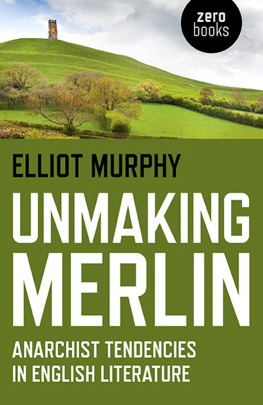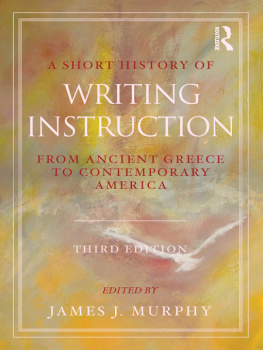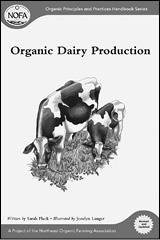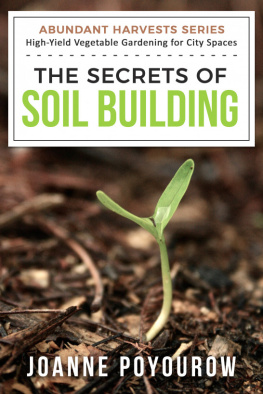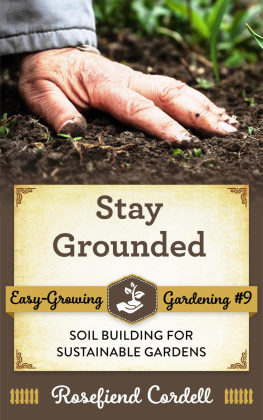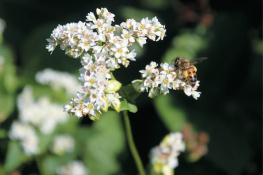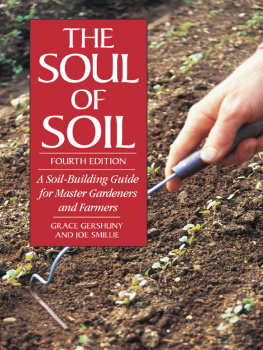BUILDING SOIL
A DOWN-TO-EARTH APPROACH
NATURA SOLUTIONS for BETTER GRADENS and YARDS
ELIZABETH MURPHY

First published in 2015 by Cool Springs Press, an imprint of Quarto Publishing Group USA Inc.,
400 First Avenue North, Suite 400, Minneapolis, MN 55401 USA
2015 Quarto Publishing Group USA Inc.
Text 2015 Elizabeth Murphy
All rights reserved. With the exception of quoting brief passages for the purposes of review, no part of this publication may be reproduced without prior written permission from the Publisher.
The information in this book is true and complete to the best of our knowledge. All recommendations are made without any guarantee on the part of the author or Publisher, who also disclaims any liability incurred in connection with the use of this data or specific details.
We recognize, further, that some words, model names, and designations mentioned herein are the property of the trademark holder. We use them for identification purposes only. This is not an official publication.
Cool Springs Press titles are also available at discounts in bulk quantity for industrial or sales-promotional use. For details write to Special Sales Manager at Quarto Publishing Group USA Inc.,
400 First Avenue North, Suite 400, Minneapolis, MN 55401 USA.
To find out more about our books, visit us online at www.coolspringspress.com.
Digital edition: 978-1-62788-612-3
Softcover edition: 978-1-59186-619-0
Library of Congress Cataloging-in-Publication Data
Murphy, Elizabeth, 1976 author.
Building soil : a down-to-earth approach : natural solutions for better gardens & yards / Elizabeth Murphy.
pages cm
ISBN 978-1-59186-619-0 (sc)
1. Soils. 2. Soil management. I. Title.
S591.M984 2015
631.4dc23
2014036112
Acquisitions Editor: Mark Johanson
Project Manager: Madeleine Vasaly
Art Director: Cindy Samargia Laun
Cover Designer: Erin Seaward-Hiatt
Book Designer: Wendy Holdman
Photographer: Crystal Liepa Photography (except as noted on )
Illustrator: Bill Kersey
10 9 8 7 6 5 4 3 2 1
CONTENTS
INTRODUCTION
W hy soil? For me, its a love affair. I find nothing more satisfying than digging between my garden rows and pulling up a handful of loose, dark, and sweet-smelling dirt. It is a handful that breaks apart with perfect spongy softness, a bounty of red wrigglers falling between my fingers. In that scoop of living earth is immediate gratification that I must be doing something right in my garden, though exactly what and how are sometimes a mystery. That mystery of the soil, for me, is part of what makes gardening an art.
If you are reading this book, your love affair may have already begun. There is something in our very nature that draws us to soil. It is the ground on which we walk and creates the contours and colors of where we live. In France, it is terroir, which defines the qualities of a wine. The world over, it is earth itself. In our lives, we are grounded when our roots stretch deep in a community or place. From it, we pull the very food that sustains and nourishes us. It is the mysterious medium in which a seed is planted and new life begins, to bloom, bear fruit, or grow tall.
Nonetheless, how does a love for soil help to translate fertilizer labels, determine when and how much to water, or help build compost? What can we do with the materials we have at hand to build the soil in a sustainable way? Why would we test our soil and what does it mean? Most of all, how can we create more verdant, productive, and beautiful gardens by working less and enjoying the process more?
In the age of industrial agriculture, our intuitive knowledge of how to build healthy soils as the foundation for healthy gardens needs rediscovery. In my own search to rediscover soils, I often wanted a practical guide to the what, when, and how of caring for my soil. This book aims to do just that, combining what Ive learned over a decade of farming, gardening, soils research, and teaching into a clear and practical guide for building your garden from the ground up. Far from being a complicated process, this comes down to a few basic principles that can guide almost any gardening decision.
My love of soils began with my first vegetable patch in our Oakland, California, neighborhood community garden. In the middle of inner-city concrete, hilling up rows of dirt and turning messy compost satisfied an unfulfilled need. We packed the worm bins with scraps from our kitchen and saw our plots transformed with the gooey black compost the worms provided. Building up the soil in a once-vacant lot brought existing fig trees and lilac bushes back to life. Soon, the eighth-acre garden started to attract birds, butterflies, and raccoons. One day, I was laid flat on the ground by thousands of bees swarming just overhead, darkening the sky with an inescapable hum; as one of the few green islands in our neighborhood, the garden had naturally attracted the drifting bees. The garden began to serve as a focal point for the neighborhood as well. People wandered through it on evening walks or rested in the shade on a sunny day. Transforming this spot in the city by transforming the soil seemed nothing less than miraculous to me.
My neighborhood community garden started my love affair with soil.
This experience led me to work on numerous small, organic farms throughout the Pacific Northwest, learning valuable lessons from both farms that focused on caring for the soil and farms that focused on the crop. Though both could pull in a good harvest, there was a difference in how the farm looked and felt, whether there was bare earth compacted by tractor tires or bountiful hedgerows lining the fields. I wondered how we could best match caring for the soil with ensuring a good crop while meeting the farmers bottom line and not breaking our backs in the process.
Eventually, on a winding search for answers to these questions, I found myself in a soils laboratory at the University of California, Davis. There, I joined the frontlines of soil organic matter research, investigating the material that is the foundation of healthy soils. We strained the limits of technology to get a closer look at soil organic matter. There were a lot of questions that begged for answers. What is its exact chemical composition? How does it interact with both the living and the nonliving parts of the soil? And why exactly does it have such a profound effect on everything from feeding the world to pollution to climate change?
When I left the lab to become an agricultural extension agent in southwestern Oregon, soil organic matter remained a recurring theme in my new job as well. Answers for many of the questions that flooded my desk often came back to building healthier soils. Adding soil organic matter to create a more resilient garden and farm helped with everything from weed problems to chicken influenza. For farmers, the key to a successful business lay in reducing the costs of inputs, such as fertilizer, fuel, and water. Caring for the soil first, by building organic matter, reduced the need for inputs, and in the long term could determine the profit-breaking point for organic and conventional farms alike. For Master Gardeners, learning to care for the soil meant that, over time, labor could be reduced and enjoyment increased.


